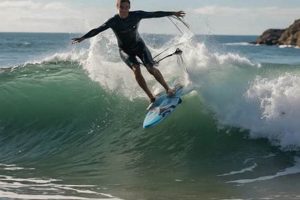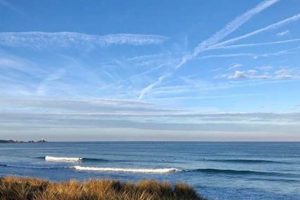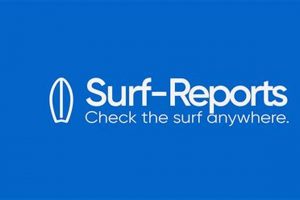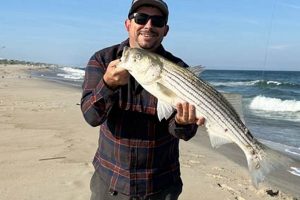Information pertaining to wave conditions along the Southern California coastline is essential for surfers, boaters, and other ocean enthusiasts. These assessments typically include details about wave height, swell direction, wind speed and direction, and tide information, providing a snapshot of current and predicted ocean conditions. For instance, a typical summary might state: “Waves are 2-3 feet from the west-northwest, winds are light onshore, and high tide is at 10:00 AM.”
The value of such data lies in its ability to inform decision-making. Surfers use it to determine the suitability of various locations for riding waves. Boaters rely on it to assess potential hazards and plan safe routes. Coastal communities benefit from the insights provided, which can aid in predicting potential coastal erosion and other weather-related impacts. Historically, gathering such information was a manual process, but advancements in technology have led to sophisticated forecasting models and real-time data collection methods, significantly improving accuracy and availability.
A detailed understanding of these reports necessitates exploring the sources from which this data is derived, the tools used in its creation, and the specific parameters that contribute to an accurate coastal conditions forecast. Subsequent sections will delve into these areas, providing a thorough overview of the factors influencing wave conditions in Southern California.
Interpreting Coastal Condition Assessments
Effectively utilizing a Southern California wave condition assessment requires a discerning approach. The following points outline key considerations for accurately interpreting the information presented.
Tip 1: Identify the Source. Verify the reliability of the information provider. Official meteorological agencies and established coastal observation networks are generally more trustworthy than unverified online sources.
Tip 2: Understand Swell Direction. The angle from which ocean swells approach the coast significantly impacts wave quality and surfability at different locations. A west swell, for example, will typically favor beaches with west-facing exposures.
Tip 3: Analyze Wave Height Data. Pay close attention to both the reported wave height and the method of measurement (e.g., buoy data, visual estimates). Different methods can yield varying results. Lower estimateds are frequently more accurate for determining surfability.
Tip 4: Evaluate Wind Conditions. Onshore winds often create choppy, disorganized waves, while offshore winds can groom the wave face for a smoother ride. Light or variable winds are typically optimal.
Tip 5: Check Tidal Information. Tidal fluctuations can dramatically alter wave characteristics, particularly at beach breaks and reef breaks. Understanding the state of the tide is crucial for anticipating wave behavior.
Tip 6: Consider Local Bathymetry. The underwater topography of a surf spot significantly influences how waves break. Familiarity with the bathymetry of a given location enhances the ability to predict wave patterns.
Tip 7: Acknowledge Forecast Limitations. Wave forecasts are inherently probabilistic and subject to error. Regularly compare forecasted conditions with real-time observations to refine one’s interpretive skills.
By paying close attention to these factors, individuals can better leverage available resources to make informed decisions regarding water activities in Southern California.
The ability to accurately interpret wave information is crucial; this understanding is essential for safe and enjoyable experiences along the Southern California coast. The following section will cover frequently asked questions.
1. Wave Height
Wave height serves as a foundational element within any wave condition assessment for Southern California. This single metric significantly influences the suitability of various locations for surfing and other aquatic activities, demanding precise measurement and careful interpretation.
- Measurement Techniques
Wave height can be determined through various methods, including buoy data, satellite altimetry, and visual observation. Each method offers a different level of precision and coverage. Buoy data, for instance, provides real-time measurements at specific locations, while satellite altimetry offers a broader spatial view, albeit with lower resolution. These measurement discrepancies impact the reported values and should be considered when evaluating wave conditions.
- Swell vs. Wind Waves
Oceanic wave height reports often differentiate between swell waves and wind waves. Swell waves are generated by distant weather systems and travel long distances, arriving as clean, organized sets. Wind waves, conversely, are locally generated by immediate wind conditions and tend to be choppier and less predictable. Distinguishing between the two allows for a more accurate assessment of surf quality.
- Breaking Wave Height
While offshore wave height indicates the size of the approaching swell, breaking wave height is a more relevant metric for surfers. Breaking wave height is influenced by factors such as bathymetry, swell period, and tidal stage. Consequently, an accurate wave assessment will consider these factors to estimate the actual size of the waves breaking on the beach.
- Forecasted vs. Observed Wave Height
Wave assessments frequently include both forecasted and observed wave heights. Forecasted values are based on numerical models and are subject to inherent uncertainties. Comparing forecasted and observed values provides insight into the reliability of the forecast and allows for adjustments in surf plans. Discrepancies between predicted and actual wave heights highlight the dynamic nature of coastal conditions.
Ultimately, the utility of a wave condition report for Southern California hinges on the accurate measurement, interpretation, and application of wave height data. Integrating this information with other parameters, such as swell direction and wind conditions, yields a comprehensive understanding of coastal conditions and supports informed decision-making.
2. Swell Direction
Swell direction, indicating the compass bearing from which ocean swells approach the Southern California coastline, is a critical parameter within any comprehensive wave condition assessment. This element dictates which beaches will receive the brunt of the incoming wave energy, directly influencing surf quality and safety across different coastal locations. Understanding swell direction is therefore paramount when interpreting reports for specific areas.
- Optimal Exposure
Southern California’s coastline features varied orientations, from predominantly west-facing to south-facing stretches. A west swell, for example, will generally produce larger waves at beaches with a direct western exposure, such as those in Los Angeles County, while leaving south-facing beaches like those around Dana Point relatively sheltered. Knowing the orientation of a particular beach in relation to the swell’s direction allows surfers to select locations likely to offer optimal wave conditions.
- Swell Windows and Obstructions
Geographical features, such as islands or headlands, can obstruct or filter swells from certain directions. Catalina Island, for example, can block some southwest swells from reaching beaches in Long Beach and Huntington Beach. This creates “swell windows,” where specific swell directions provide waves to otherwise less-exposed areas. Consequently, coastal assessments should consider the local geography and its effect on swell propagation.
- Refraction and Diffraction
As swells approach the coastline, they undergo refraction (bending) and diffraction (spreading) due to variations in water depth and coastal geometry. Refraction can concentrate wave energy at certain points, creating larger waves at those locations, while diffraction can cause swells to wrap around obstacles, reaching sheltered areas with reduced intensity. Surf reports often implicitly incorporate these effects, but a deeper understanding of these physical processes improves the accuracy of site-specific predictions.
- Combined Swell Events
Southern California often experiences simultaneous swells from different directions. A combination of a west swell and a south swell, for instance, can create complex wave patterns and challenging surf conditions. Reports must clearly articulate the direction and size of each contributing swell to allow users to assess the overall impact on wave quality and to anticipate potentially unpredictable wave behavior.
The ability to interpret the interplay between swell direction, coastal orientation, and geographical features is essential for effective utilization of wave information. By integrating swell direction data with local knowledge and real-time observations, coastal users can make informed decisions about when and where to engage in water activities, maximizing their safety and enjoyment.
3. Wind Speed
Wind speed constitutes a crucial element within a Southern California wave condition report. The magnitude of wind directly impacts sea surface conditions, influencing wave formation and overall surf quality. The cause-and-effect relationship is straightforward: higher wind speeds generate more chop and turbulence, negatively impacting wave shape and predictability. In the context of wave condition assessments, wind speed is presented in miles per hour or knots, providing surfers, boaters, and coastal residents with critical information for assessing safety and desirability. For example, a report indicating “winds at 20 mph onshore” suggests choppy conditions unfavorable for surfing at exposed breaks. Conversely, light offshore winds often groom waves, creating smoother, more rideable faces.
The significance of wind speed extends beyond surfing. Coastal navigation relies heavily on accurate wind forecasts. Boaters use wind speed data to assess potential hazards and plan safe routes. High wind warnings, frequently incorporated into wave condition reports during storm events, are crucial for preventing maritime accidents and protecting coastal property. Furthermore, wind speed forecasts are integral to coastal erosion prediction models, informing beach management and shoreline protection efforts. During Santa Ana wind events, for instance, offshore winds can significantly reduce wave size and create fire hazards, drastically altering both surf conditions and overall coastal risks.
In summary, wind speed’s inclusion in Southern California wave assessments is not merely an ancillary detail; it is a fundamental component that directly affects both wave characteristics and coastal safety. Understanding the impact of varying wind speeds is crucial for interpreting wave conditions accurately, mitigating risks, and making informed decisions regarding recreational activities and coastal management. Ignoring wind speed data can lead to misjudgments of surfability, increased risk of maritime incidents, and inadequate preparation for coastal hazards.
4. Tidal Influence
Tidal influence represents a key variable in any credible assessment of wave conditions along the Southern California coastline. The gravitational forces exerted by the moon and sun create predictable cyclical variations in sea level, which, in turn, directly affect wave characteristics and surf quality at specific locations. These fluctuations alter water depth, impacting wave refraction, breaking patterns, and the availability of rideable surf. Therefore, “surf report socal” that omits or inadequately addresses tidal dynamics fails to provide a complete or reliable picture of current conditions. For instance, a beach break that performs optimally during mid-tide may become entirely flat during low tide or dangerously close out during high tide. Similarly, a point break that relies on deep water channels may become unsurfable if low tide exposes the reef.
The effects of tidal influence are compounded by the bathymetry unique to each surf location. Some areas experience pronounced tidal swings, where the difference between high and low tide can be several feet, drastically altering wave shape and intensity. Other locations are less sensitive to tidal variations due to deeper offshore waters or protective reefs. Furthermore, the timing of high and low tides relative to swell arrival plays a critical role. A large swell coinciding with a high spring tide can lead to powerful, surging conditions that pose risks to less experienced surfers. Conversely, the same swell arriving during a low neap tide may produce more manageable, user-friendly waves.
In conclusion, tidal influence is not merely a supplemental detail, but an integral component of a reliable “surf report socal.” Understanding the interplay between tidal stage, swell direction, wave height, and local bathymetry is essential for safe and enjoyable surfing experiences. Surf reports should clearly indicate the current and predicted tidal levels, allowing users to anticipate changes in wave conditions and make informed decisions regarding surf spot selection and water safety. Failure to consider tidal effects leads to inaccurate wave predictions and potential misjudgments of surf conditions, which can have serious consequences.
5. Water Temperature
Wave condition assessments for Southern California frequently include water temperature as a key parameter. This factor influences both surfer comfort and the potential for marine life encounters, thereby contributing to overall risk assessment and enjoyment of coastal activities. Neglecting water temperature in a “surf report socal” presents an incomplete picture of the coastal environment.
- Wetsuit Selection
Water temperature directly dictates the appropriate exposure protection required for extended surfing sessions. Suboptimal wetsuit selection based on inaccurate or absent temperature information can lead to hypothermia or hyperthermia, affecting performance and safety. A report indicating water at 60F necessitates a full wetsuit, while 70F might allow for a spring suit or rash guard.
- Marine Life Activity
Water temperature affects the distribution and behavior of marine organisms, including sharks, jellyfish, and various fish species. Warmer waters can attract certain species, increasing the likelihood of encounters. A “surf report socal” incorporating recent sightings alongside temperature data offers enhanced situational awareness, allowing surfers to make informed decisions about surf spot selection.
- Upwelling Events
Sudden drops in water temperature due to upwelling events are common along the California coast. These events can significantly lower water temperature within hours, impacting both comfort and marine life activity. Wave condition assessments should ideally incorporate real-time temperature data to reflect these dynamic changes, providing a more accurate representation of coastal conditions.
- Seasonal Variations
Southern California water temperatures exhibit predictable seasonal variations. Summer months generally see warmer water, while winter brings colder conditions. “Surf report socal” should account for these seasonal trends and provide context for current temperatures, allowing surfers to anticipate and prepare for typical temperature ranges for specific times of the year.
Incorporating accurate water temperature data into coastal condition assessments improves user decision-making, promoting safer and more comfortable experiences. Omission of this parameter limits the utility of the “surf report socal”, potentially compromising both well-being and enjoyment. This is a vital consideration for all ocean users along the Southern California coastline.
6. Local Hazards
The inclusion of local hazards within a Southern California coastal conditions report is essential for informed decision-making regarding water activities. Neglecting such information introduces unacceptable risk to surfers, swimmers, and boaters. A comprehensive “surf report socal” must extend beyond wave height and wind speed, addressing specific dangers unique to individual locations. These hazards frequently include submerged rocks, rip currents, marine life, and man-made structures. Failure to acknowledge these risks can lead to serious injury or fatality. For example, a popular surf break may feature a known aggregation of sharp, shallow rocks exposed during low tide. A credible report should explicitly warn of this condition and the associated risks of lacerations or board damage. Similarly, the presence of strong rip currents, particularly after periods of high surf, warrants clear articulation within the report, coupled with guidance on rip current identification and escape strategies.
Marine life, including sharks, jellyfish, and stingrays, presents another category of local hazard. Reports should include information about recent sightings or known seasonal patterns of these creatures, enabling users to adjust their behavior accordingly. While direct attacks are infrequent, awareness of potential encounters mitigates risk. Furthermore, man-made structures such as piers, jetties, and submerged pipelines pose collision hazards, particularly in areas with reduced visibility or strong currents. Charts indicating the location of these structures and advisories regarding safe navigation distances should be incorporated into the report. Certain beaches in Southern California are known to experience significant pollution events following heavy rainfall. Reports should include information on water quality advisories, enabling users to avoid potentially contaminated areas.
In summary, the integration of local hazard information into a “surf report socal” transforms it from a general overview of wave conditions into a location-specific safety bulletin. The omission of these details compromises the report’s utility and increases the likelihood of accidents. A responsible and thorough coastal conditions assessment prioritizes the identification and communication of local hazards, empowering users to make informed decisions and minimize risks associated with water activities. The ability to identify and avoid these hazards is paramount for safe enjoyment of the Southern California coastline.
7. Forecast Accuracy
Forecast accuracy forms the bedrock of any reliable “surf report socal.” The inherent value of a coastal condition assessment hinges upon its ability to predict future wave states with a reasonable degree of precision. Inaccurate forecasts render the information useless, potentially leading to dangerous situations for those who rely upon them. A deficient forecast compromises the utility of a “surf report socal,” regardless of the sophistication of other included data.
- Model Limitations
Numerical weather prediction models, the engines driving wave forecasts, operate based on complex algorithms and extensive datasets. However, these models are inherently limited by imperfect data assimilation, computational constraints, and an incomplete understanding of oceanic and atmospheric processes. Small errors in initial conditions can amplify over time, leading to significant deviations between forecasted and observed conditions. The ability of any “surf report socal” to provide accurate information is constrained by these model limitations.
- Ensemble Forecasting
To address model uncertainty, advanced “surf report socal” often employ ensemble forecasting techniques. Instead of relying on a single model run, ensemble systems generate multiple forecasts from slightly perturbed initial conditions. The spread among ensemble members provides an indication of forecast uncertainty. A narrow spread suggests higher confidence, while a wide spread indicates greater variability and lower predictability. Interpreting ensemble forecasts allows users to assess the range of possible outcomes and make more informed decisions.
- Verification Metrics
The accuracy of a “surf report socal” can be assessed through various verification metrics, such as root mean square error (RMSE), bias, and correlation coefficient. These metrics quantify the discrepancy between forecasted and observed wave parameters. Regular verification studies provide valuable insights into the strengths and weaknesses of different forecasting models and allow for continuous improvement. Transparency regarding forecast verification bolsters the credibility of a “surf report socal”.
- Human Interpretation
While numerical models provide the foundation for wave forecasting, human expertise remains essential for interpreting and refining model outputs. Experienced meteorologists and surf forecasters possess the ability to identify model biases, account for local effects, and incorporate real-time observations into their predictions. A well-crafted “surf report socal” integrates both model-derived forecasts and human expertise, offering a more nuanced and reliable assessment of coastal conditions.
The interplay between model limitations, ensemble forecasting, verification metrics, and human interpretation ultimately determines the forecast accuracy of a “surf report socal.” Recognizing the inherent uncertainties in wave prediction and acknowledging the limitations of any forecasting system is essential for responsible coastal management and safe recreational activities. The more comprehensive and transparent that wave condition assessment is, the more trust can be given in the report.
Frequently Asked Questions Regarding Wave Condition Information for Southern California
This section addresses common inquiries concerning the acquisition, interpretation, and utilization of wave condition data pertaining to Southern California’s coastal regions.
Question 1: What sources provide the most reliable “surf report socal”?
Government meteorological agencies, such as the National Weather Service, and established coastal observation networks typically offer the most reliable wave condition assessments. These entities employ calibrated instruments and validated forecasting models.
Question 2: How frequently are “surf report socal” updated?
Update frequency varies depending on the source. Real-time data from buoys may be available hourly, while forecasts are often updated several times daily to reflect evolving weather patterns.
Question 3: What is the difference between “swell height” and “wave height” in a “surf report socal”?
Swell height refers to the size of the open-ocean swell before it reaches the coast. Wave height represents the actual size of the breaking wave, which is influenced by swell height, bathymetry, and tidal stage.
Question 4: How does wind speed affect the accuracy of a “surf report socal”?
Wind speed can significantly impact wave quality. Onshore winds tend to create choppy, disorganized waves, while offshore winds can groom the wave face. High wind speeds introduce greater forecast uncertainty.
Question 5: Where can historical wave condition data be accessed to analyze trends?
Government agencies and academic institutions often archive historical wave condition data. These datasets can be used to analyze seasonal trends, identify storm patterns, and assess long-term coastal changes.
Question 6: What factors contribute to inaccuracies in “surf report socal” forecasts?
Model limitations, incomplete data assimilation, and unpredictable atmospheric events contribute to forecast inaccuracies. Local bathymetry and coastal geography also introduce complexities that are difficult to model precisely.
Understanding these factors enhances the ability to effectively utilize available resources and to interpret wave condition information accurately, but further research is advised for individual safety and awareness.
Subsequent sections will delve into strategies for mitigating risks associated with coastal activities, considering wave conditions, and understanding associated local hazards.
The Indispensable “Surf Report Socal”
This discourse has underscored the vital role of reliable “surf report socal” in promoting coastal safety and informed decision-making. Accurate assessments of wave height, swell direction, wind speed, tidal influence, water temperature, and local hazards are paramount for those engaging in water activities along the Southern California coastline. The inherent complexities of wave forecasting necessitate the integration of robust data sources, sophisticated modeling techniques, and experienced human interpretation.
Continued advancements in observational technologies and predictive algorithms promise to enhance the precision and utility of coastal condition reports. Responsible utilization of these resources, coupled with a commitment to ongoing education and heightened awareness of local conditions, remains crucial for mitigating risks and ensuring the sustainable enjoyment of Southern California’s coastal environment. Prioritizing safety and informed decision-making is paramount for all coastal users.




![Your San Diego La Jolla Surf Report: [Conditions & Forecast] Learn to Surf & Skate: A Beginner's Step-by-Step Guide Your San Diego La Jolla Surf Report: [Conditions & Forecast] | Learn to Surf & Skate: A Beginner's Step-by-Step Guide](https://universitysurfandskate.com/wp-content/uploads/2025/12/th-897-300x200.jpg)


